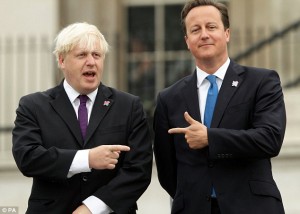Context Effects: PayPal and Brexit

Whom do you trust?
PayPal was recently skewered on social media because it sponsored a panel discussion on gender equality and inclusion in the workplace. The problem was that the panel consisted solely of men. Women quickly tore into the company on Twitter and Tumblr for being tone deaf and sexist.
In fairness to PayPal, the panel discussion was supposed to have been titled: “Gender Equality and Inclusion In the Workplace: A Conversation With Our Male Allies”. Somehow, the organizers omitted the last part of the title from the official program.
I suspect that PayPal’s panel was a well-intentioned effort to bridge the gender gap. But the organizers made a simple mistake – they focused on strategy and forgot about context.
In persuasion, we typically start by developing the message strategy. What is the key message that we need to communicate? How can we best encapsulate that message in a memorable campaign?
While message strategy is certainly critical, it’s not the only concern. We also need to consider the context the message is delivered in. It’s a fairly simple question: does the context create an opportunity to deliver our message effectively? Sometimes, contextual factors facilitate the message delivery. At other times, the context constrains our ability to communicate clearly. Creating an all-male panel on gender equality does not provide a favorable context.
From a timing perspective, Greek rhetoricians called this kairos. Translated literally, it means the “supreme moment”. In our context, kairos means finding the opportune moment to deliver a persuasive message. As Jay Heinrichs points out, it’s analogous to a teachable moment. A teacher finds the right moment to teach a memorable lesson. Similarly, a persuader finds the right moment to deliver a persuasive message.
Kairos refers to timing and timeliness. But we need to consider other contextual factors as well. Who delivers the message? In what forum? What is the audience ready to receive? Whom does the audience trust? What media and channel provide the best opportunity to deliver the message successfully?
In this context, I wonder about the Brexit campaign in the United Kingdom. One side – the Remain campaign — argues that Britain will be stronger by staying in Europe. The other side – the Leave campaign — argues that leaving will make Britain great again. Both sides have worked out their message strategies.
Polls suggest that the two sides are very evenly divided. Both sides have strong messages. Neither has a clear advantage. Given this, which side will be more persuasive? In my humble opinion, it will be the side that makes best use of contextual factors. In this regard, the Leave campaign has a clear advantage.
While the Remain campaign has a solid message, it’s misreading the context. More specifically, it’s using the wrong messengers (again, in my humble opinion).
Here’s the context. Voters who support the Leave campaign perceive that their economic situation has deteriorated since Britain joined the European Union. They also perceive that joining the Union was a project conceived and championed by the “elite”. It’s easy to conclude that the elite classes have “sold us out”.
And who is speaking for the Remain campaign? By and large, it’s the elite. We hear from top managers, bankers, executives, rich people, and assorted toffs. We even hear from the head of the IMF, who happens to be French. Now, we even hear from the president of the United Sates.
Who are these people? They’re the elites – exactly the people whom the Leavers don’t trust. The easy response from the Leave campaign: “Well, you remember what happened the last time we trusted them.”
If the Remain campaign continues to pursue an elite strategy, I suspect the Leave campaign will win – and by a wide margin. What’s the lesson in all this? Whether you’re PayPal or the British Prime Minister, consider the context.
Social Media and Empty Calories

I’m at my bliss point.
Can’t stop eating those potato chips? Blame it on the bliss point.
On a graph, the bliss point looks like an upside-down U. Think of it as a crave curve. At the top of the curve, the food you’re eating provides maximum bliss and minimum warning. You crave it and simply want more. If you move past the top of the curve, however, the food starts to alert your brain that you’ve eaten enough. You stop eating.
Being good marketers, food engineers want you to eat more. They aim to hit the top of the crave curve. As it happens, “…big, distinct flavors [tend] to overwhelm the brain, which responds by depressing your desire to have more.” So food engineers blend flavors to get just the right bliss balance that will keep you consuming.
As with food, so with slot machines. As the anthropologist Natasha Dow Schüll points out, slot machine designers aim for a mechanical version of the bliss point called the “machine zone”.
Once players enter the machine zone, their “…worries, social demands, and even bodily awareness fade away. … gambling addicts play not to win but simply to keep playing as long as possible….” Like food engineering, game engineering aims to keep you going … just one more nibble or one more pull on the slot machine’s arm.
I wonder if social media doesn’t work the same way. It’s simple, it’s repetitive, and it’s enjoyable. Just one more peek … it’s an innocent pastime, isn’t it? It can’t really hurt anything, can it?
I took a short break just a moment ago and checked my social media. What did I learn? Well, I found out what a former colleague had for lunch today in Minneapolis. Did I really want to know that? No … but think of what I might have learned. I might have found that several people “liked” my latest article. I might have learned that a professional association wants to hire me for a keynote speech. I might have discovered that Tilda Swinton wants to invite me to lunch. Oh, the possibilities.
There’s an old joke that second marriages are the triumph of hope over knowledge. The same is true for social media. The reality is that most of what we discover on social media is rather boring. But maybe … just maybe … something interesting has happened. We have to check. It’s like being in the machine zone. Our worries and social obligations just fade away.
And when something interesting does happen, we get a little reward, just like a slot machine. In reality, the reward never equals the investment. But, as we bask in the glow of the reward, we forget that. We’re in the zone. We can’t break away. In fact, we don’t even want to break away.
My Mom used to say that it’s easier to avoid temptation than to resist it. I’ve learned not to stock potato chips in the house. I’ve learned not to frequent gaming dens. Maybe it’s time to put the social media away, too.
Making Internal Social Media Work

Now let’s try it internally
When I joined Lawson Software in 2006, it was merging with another software company, Intentia. Both companies had roughly 2,000 employees. Lawson was headquartered in St. Paul, Minnesota and 95% of its revenues came from the United States. Intentia was based in Stockholm and 95% of its revenues came from Europe. We were merging two regional companies to create one global company.
I was responsible for merging the two marketing departments. I found employees scattered all over the globe and no shortage of ideas on how we should integrate and communicate the “new Lawson”. I met people as quickly as I could and asked for suggestions on how to build an internal infrastructure, integrate marketing operations, share the best ideas from around world, and re-brand the combined company.
One idea I heard frequently was, “Let’s launch a wiki.” So we did. Marketing staff could share ideas and get acquainted through a global marketing wiki. We found some free software, organized it minimally, and launched it. I sent out an e-mail endorsing the idea and inviting everyone to participate.
Then I stood aside. I was familiar with the traditional wisdom that, “The surest way to stifle innovation is to let the boss speak first.” So, instead of participating actively, I let others take the lead. I assumed that was the best way to bring out creative ideas that we could mash up into effective innovations.
The wiki launched with a surge of enthusiasm. But it didn’t last long. Some people dominated the conversations; other people shied away. Conversational threads spun off into infinity. I thought the wiki would be an excellent place to share ideas and processes. As it evolved, mostly it was a place to share opinions – sometimes heatedly. Ultimately, it sank into irrelevance.
I could have saved a lot of time and effort, if only I had had McKinsey’s new report on social media as an internal integrator. McKinsey notes that many companies have invested in social media for external use but that, “…internal applications have barely begun to tap their full potential.” McKinsey also notes that companies could unlock up to $1.3 trillion in annual value through “products and services that enable social interactions in the digital realm.”
How to unlock that value? McKinsey suggests we follow four basic principles:
Add value, not complexity – the best social technologies “… become central to the organization and complement (or, ideally, substitute for) existing processes.” Our little wiki at Lawson was one more thing to do, not one less.
Provide essential organizational support – identify your objectives, select a technology, and then figure out what support and encouragement is needed to make it work. One of McKinsey’s clients used “Connections Geniuses” to encourage people to use the social technology. At Lawson, I thought the wiki was simple enough for everyone to use. Actually, it probably was but I forgot the need for ongoing encouragement.
Experiment and learn – as Tom Kelley points out in another context, treat everything as an experiment. Experiments only fail if you don’t learn anything from them. As our wiki sank into obscurity, we just let it go rather than learning from it and trying again.
Track impact and evolve metrics – when you’re experimenting, you’re not always sure what the best metrics are. Don’t jump the gun and commit prematurely – you may be measuring the wrong thing. Rather, let the experiment proceed and then decide how best to measure its impact.
Social Media Gets Creepy

Yikes! It’s Twitter!
As we discussed social media in my branding class, one of my students noted that she was inundated with bridal ads when she announced her engagement on Facebook. That seemed a little creepy – an event in your private life fuels a targeted, persistent ad campaign. Still, with the new rules of Facebook, it’s not unexpected.
A few months ago, I wrote a brief article about Twitter‘s ability to identify your location and your relationships. In turn, that information could power an innovative (and free) package delivery service. The delivery service sounds like a good idea, but the fact that Twitter can identify your location with such precision and immediacy seems a little creepy.
On Saturday, I read an article about college admissions officers. They’re now using social media to understand their applicants better. In some cases, they’re using social media to reject applicants who are otherwise qualified. You could be ready to go to the school of your choice when they discover that you’re a bit of a jerk and decide that you’re not the kind of person they want in their school.
If I applied for a job, I would expect the human resources department to check me out online. That’s appropriate due diligence and doesn’t seem creepy. But to check on teenagers as they apply for college? That seems creepy. They’re teenagers; of course they say stupid stuff. It’s creepy to expect them not to.
Then I read an article in Technology Review that assesses how software will soon be able to assess our personalities via our tweets. The goal is “to go below behavioral analysis like Amazon does,” says an IBM researcher. “We want to use social media to derive information about an individual—what is the overall affect of this person? How resilient is this person emotionally? People with different personalities want something different.”
If all goes well (?), the software will review your Twitter feed and assess your Big Five personality traits: extroversion, agreeableness, conscientiousness, neuroticism, and openness to experience. It could also score your values (hedonism, conservatism, etc.) and needs (curiosity, need for harmony, etc.).
And what would they do with all this information? Target ads at you, of course. If advertisers understand your individual psychology, they can tune their messages and their content to your individual needs, emotions, fears, and desires. It’s like food engineering that’s designed to keep you eating, except that this is designed to keep you buying.
It’s creepy enough that advertisers can use your inner self to sell you stuff. But what happens next? Will potential employers assess your personality via Twitter? Will college admissions officers reject you because your Twitter psycho-scan says you’re needy? Now that’s creepy.
So, I’m wondering — as social media becomes creepier, do you feel like you’re being stalked? At what point do you think social media crosses the line and becomes too intrusive? Will any of this change your social media behavior? Let me know.
Personal Branding In The Social Media Age

How’s my brand?
When I was a teenager, my mother urged me to dress nicely because, “you do want to make a good impression, don’t you?” She even taught me how to iron my clothes so I could make a neatly pressed impression. (In fact, “pressing” clothes and making an “impression” derive from the same root). I remember asking her, “If it’s so important to make a good impression, why don’t you iron my clothes?” She answered with a smile: “It’s not that important”.
Mom also told me (repeatedly) that “you have only one chance to make a first impression.” She didn’t know it but she was speaking the language of personal branding. I’m often asked what personal branding means and I simply shrug and say, “it’s the impression you make”. We all make an impression on others, whether we intend to or not, and that impression is essentially our brand.
Another popular definition is that your personal brand is what other people say about you when you’re not around. Actually, I would distinguish between two different commentaries. When you’re not around, people can talk about what you do or who you are. The what-you-do stories are often interesting (“Did you hear what Travis did?”) but they’re not really your brand. Your brand consists of the who-you-are comments.
While the what-you-do stories can be lengthy, the who-you-are commentaries are usually quite brief – typically, 25 words or less. So your brand consists of the roughly 25 words that people speak about you when you’re not around. (This is a pretty good definition of a corporate brand as well).
If you care about your brand (some people don’t), you need to think about how to get the right words in place. My mother called it making an impression; today we call it managing your brand. But, really it’s the same thing. How do you get people to think of you in the way you want to be thought of?
One big difference between my mom’s era and today is the arrival of social media. In my mom’s day, making an impression typically meant meeting somebody face-to-face. Or it might have meant a good cover letter and resumé. (Mom was a great copy editor). Either way, it was personal.
Today, it’s not so personal. I can make a first impression on someone I’ve never met and never even heard of. Recruiters might look me up on LinkedIn. Friends of friends might see my Facebook page. Indeed, I hope that lots of people I don’t know will come to my website.
The other big difference from my mom’s era is the economy. My mother grew up in a manufacturing economy, where your skills were important. We’re now in a service economy, where your personality is important. As Tony Tulathimutte points out in The New Yorker, “Success in a service job … often involves getting people to see you as competent and likeable. … Now that what we have to offer in the service economy is ourselves, the rules of branding apply to us.”
So how do you make a good first impression these days? Think about the 25 words you want people to say about you and then work backwards. If you want people to say you’re intelligent, you better learn to write (and spell) well. If you want people to say you’re a good manager, then highlight your management expertise. As my mother used to say, “just remember to put your best foot forward”. Oh, and learn how to iron